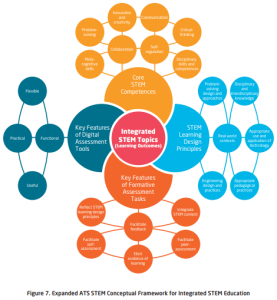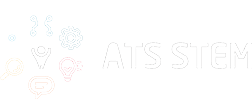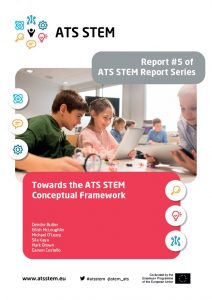16 Dec 5 Towards the ATS STEM conceptual framework
Towards the ATS STEM conceptual framework
“The integration of knowledge areas involves obtaining a final product or solution greater than the sum of its individual parts. Designing integrated experiences providing intentional and explicit support for students is important in order to build knowledge and skills both within the disciplines and across disciplines.”Key takeaways
 Policy makers should be aware of the value of integrated STEM topics for educational curricula and syllabi that can tie disciplines together to solve real world problems
Policy makers should be aware of the value of integrated STEM topics for educational curricula and syllabi that can tie disciplines together to solve real world problems- For teachers and teacher educators a conceptual framework for integrated STEM education focused on digital assessment should contain at least four elements:
- Core STEM Competencies
- STEM Learning Design Principles
- Formative Assessment STEM Tasks
- Digital Assessment Tools
- The framework should help teachers across schools in Europe to relate skills and competences to STEM, to assessment and to digital tools in unique local contexts
- The framework contains 23 sub-elements of the four main components that can be drawn upon. As such it should provide a basis for conversations about creating rich STEM learning experiences between researchers, learning designers, teachers and ultimately learners.
The Report
This report was written as a part of a research project titled Assessment of Transversal Skills in STEM (ATS STEM) funded by Erasmus+. It is the fifth in a series of five reports based on deliverables related to the ATS STEM project, intended to draw on the first four reports and present an integrated conceptual framework for the assessment of transversal skills in STEM.
In recent years, STEM education has become a high priority for governments and education policymakers around the world as it is believed to be crucial for future global economic prosperity. The underlying assumption is that countries with dynamic economies tend to have education systems that prioritise STEM education.
However, STEM is a contested concept with different drivers and constraints in different socio-political contexts. There are deep systemic issues facing many education systems in order to help students to understand how to solve real-world problems using knowledge gained through STEM disciplines.
The premise of this report is that some of these systemic issues could be alleviated by policymakers adopting a conceptual framework that outlines the relationship between and practical integration of each of the four disciplines of STEM. In addition, the role of assessments needs to be considered with guidelines developed for formative and summative assessments which leverage the use of digital technologies.
Such an integrated conceptual framework is long overdue and likely to have major implications for how teachers understand the learning domain and its goals as well as the most appropriate way to design and develop teaching, learning and assessment activities.
The research that underpins this report provides a conceptual tool to help European education reach a common understanding of what integrated STEM education is and how it can be assessed using digital tools in schools. The four essential components for designing and assessing integrated STEM topics in education are:
- Core STEM Competencies
- STEM Learning Design Principles
- Formative Assessment STEM Tasks
- Digital Assessment Tools
These four components are combined in the ATS STEM Conceptual framework which aims to inform the classroom practices of integrated STEM education topics and their assessment. Educators can benefit from this framework, which has the potential to deepen their understanding of what STEM education is and reflect it in their classroom practice.
Finally, the report is not final. It is a provisional piece of work that will be tested and validated by researchers and teachers in schools, after which a revised framework will be developed.



